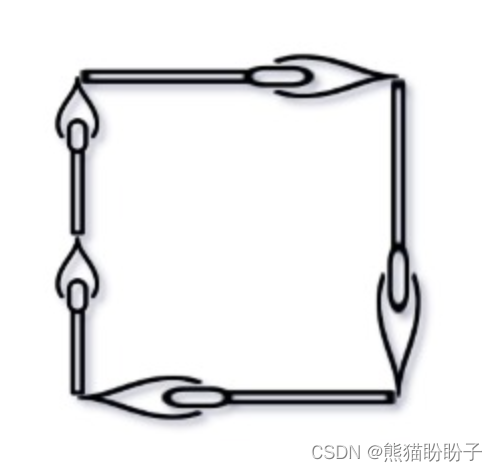目录
一、题目
你将得到一个整数数组 matchsticks ,其中 matchsticks[i] 是第 i 个火柴棒的长度。你要用 所有的火柴棍 拼成一个正方形。你 不能折断 任何一根火柴棒,但你可以把它们连在一起,而且每根火柴棒必须 使用一次 。
如果你能使这个正方形,则返回 true ,否则返回 false 。

示例 1:
输入: matchsticks = [1,1,2,2,2]
输出: true
解释: 能拼成一个边长为2的正方形,每边两根火柴。
示例 2:
输入: matchsticks = [3,3,3,3,4]
输出: false
解释: 不能用所有火柴拼成一个正方形。
提示:
1 <= matchsticks.length <= 15
1 <= matchsticks[i] <= 108
二、解题思路
首先计算所有火柴的总长度totallen,如果totallen 不是 4 的倍数,那么不可能拼成正方形,返回false。当totallen 是 44 的倍数时,每条边的边长为 totallen/4,用 edges 来记录 4 条边已经放入的火柴总长度。对于第 index 火柴,尝试把它放入其中一条边内且满足放入后该边的火柴总长度不超过len,然后继续枚举第 index+1 根火柴的放置情况,如果所有火柴都已经被放置,那么说明可以拼成正方形。
为了减少搜索量,需要对火柴长度从大到小进行排序。
class Solution {
public:
bool dfs(int index,vector<int>& matchsticks,vector<int>& edges,int len){
//递归结束条件
if(index==matchsticks.size())
{
return true;
}
for(int i=0;i<edges.size();i++){
edges[i]+=matchsticks[index];
if(edges[i]<=len && dfs(index+1,matchsticks,edges,len)){
return true;
}
edges[i]-=matchsticks[index];
}
return false;
}
bool makesquare(vector<int>& matchsticks) {
int index=0;
int totallen=accumulate(matchsticks.begin(),matchsticks.end(),0);
int len=totallen/4;
if((totallen%4)!=0){
return false;
}
vector<int> edges(4);
//降序排序
sort(matchsticks.begin(),matchsticks.end(),std::greater<int>());
if(dfs(index,matchsticks,edges,len)){
return true;
}
else{
return false;
}
}
};三、知识总结
1.C++ sort()排序函数用法详解
该函数专门用来对容器或普通数组中指定范围内的元素进行排序,排序规则默认以元素值的大小做升序排序,除此之外我们也可以选择标准库提供的其它排序规则(比如std::greater<T>降序排序规则),甚至还可以自定义排序规则。
sort() 函数是基于快速排序实现的
sort() 函数受到底层实现方式的限制,它仅适用于普通数组和部分类型的容器。换句话说,只有普通数组和具备以下条件的容器,才能使用 sort() 函数:
- 容器支持的迭代器类型必须为随机访问迭代器。这意味着,sort() 只对 array、vector、deque 这 3 个容器提供支持。
- 如果对容器中指定区域的元素做默认升序排序,则元素类型必须支持
<小于运算符;同样,如果选用标准库提供的其它排序规则,元素类型也必须支持该规则底层实现所用的比较运算符; - sort() 函数在实现排序时,需要交换容器中元素的存储位置。这种情况下,如果容器中存储的是自定义的类对象,则该类的内部必须提供移动构造函数和移动赋值运算符。
对于指定区域内值相等的元素,sort() 函数无法保证它们的相对位置不发生改变。
sort() 函数位于<algorithm>头文件中,因此在使用该函数前,程序中应包含如下语句:
#include <algorithm>sort() 函数有 2 种用法,其语法格式分别为:
//对 [first, last) 区域内的元素做默认的升序排序
void sort (RandomAccessIterator first, RandomAccessIterator last);
//按照指定的 comp 排序规则,对 [first, last) 区域内的元素进行排序
void sort (RandomAccessIterator first, RandomAccessIterator last, Compare comp);举例:
#include <iostream> // std::cout
#include <algorithm> // std::sort
#include <vector> // std::vector
//以普通函数的方式实现自定义排序规则
bool mycomp(int i, int j) {
return (i < j);
}
//以函数对象的方式实现自定义排序规则
class mycomp2 {
public:
bool operator() (int i, int j) {
return (i < j);
}
};
int main() {
std::vector<int> myvector{ 32, 71, 12, 45, 26, 80, 53, 33 };
//调用第一种语法格式,对 32、71、12、45 进行排序
std::sort(myvector.begin(), myvector.begin() + 4); //(12 32 45 71) 26 80 53 33
//调用第二种语法格式,利用STL标准库提供的其它比较规则(比如 greater<T>)进行排序
std::sort(myvector.begin(), myvector.begin() + 4, std::greater<int>()); //(71 45 32 12) 26 80 53 33
//调用第二种语法格式,通过自定义比较规则进行排序
std::sort(myvector.begin(), myvector.end(), mycomp2());//12 26 32 33 45 53 71 80
//输出 myvector 容器中的元素
for (std::vector<int>::iterator it = myvector.begin(); it != myvector.end(); ++it) {
std::cout << *it << ' ';
}
return 0;
}该函数实现排序的平均时间复杂度为N*log2N(其中 N 为指定区域 [first, last) 中 last 和 first 的距离)。
2.accumulate()函数
accumulate带有三个形参:头两个形参指定要累加的元素范围,第三个形参则是累加的初值。
accumulate函数将它的一个内部变量设置为指定的初始值,然后在此初值上累加输入范围内所有元素的值。accumulate算法返回累加的结果,其返回类型就是其第三个实参的类型。
可以使用accumulate把string型的vector容器中的元素连接起来:
string sum = accumulate(v.begin() , v.end() , string(" "));但是对于自定义数据类型,我们就需要自己动手写一个回调函数来实现自定义数据的处理,然后让它作为accumulate()的第四个参数;
#include <vector>
#include <string>
using namespace std;
struct Grade
{
string name;
int grade;
};
int main()
{
Grade subject[3] = {
{ "English", 80 },
{ "Biology", 70 },
{ "History", 90 }
};
int sum = accumulate(subject, subject + 3, 0, [](int a, Grade b){return a + b.grade; });
cout << sum << endl;
system("pause");
return 0;
}四、总结
编写递归函数时,必须告诉他何时停止递归。
每个递归函数都有两部分:基线条件和递归条件。递归条件指的是函数调用自己,而基线条件则指函数不再调用自己,从而避免形成无限循环。